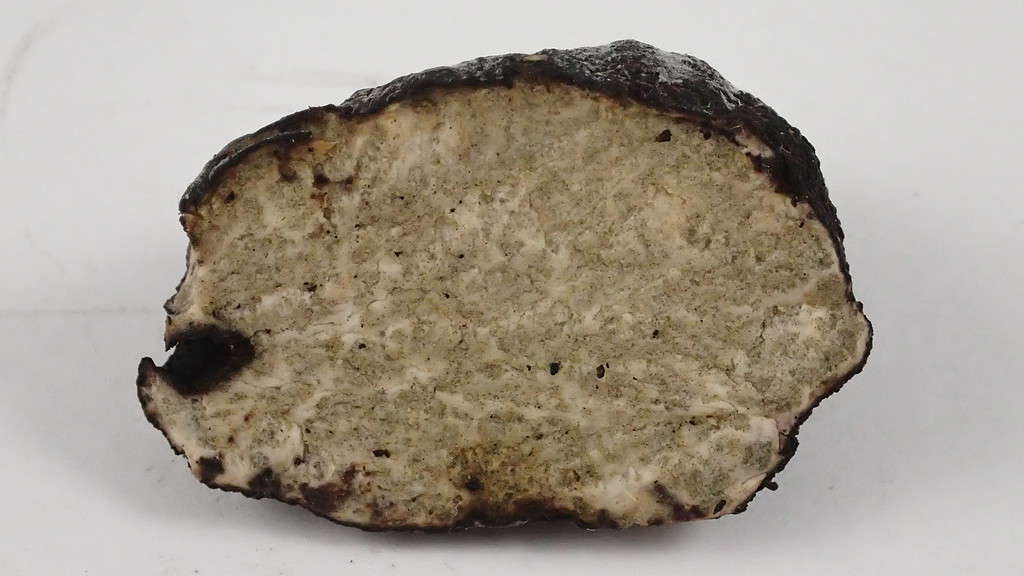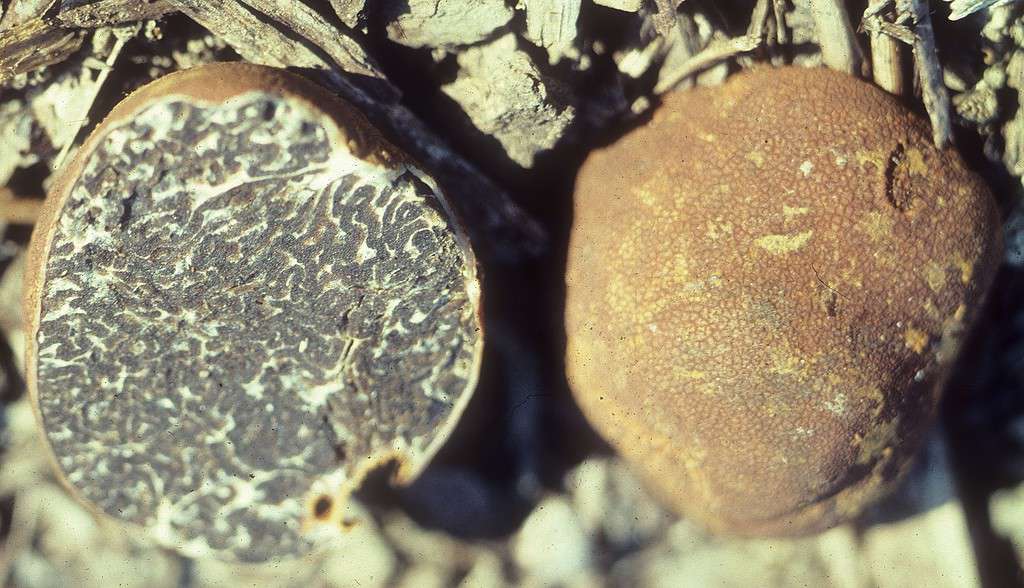Truffles are the spore-bearing fruiting bodies of subterranean ascomycete fungi across dozens of genera and multiple families within the order Pezizales. Whether truffles are a considered a mushroom depends on your mycological definition.
As it currently stands, the word “mushroom” is technically a non-scientific term generally used to describe the macroscopic fruiting bodies of fungi in either the Basidiomycota phylum or the Basidiomycota and Ascomycota phyla. Some mycologists and mycophiles only include above-ground fruiting bodies in this definition. In that case, truffles, which fruit underground and are part of the Ascomycota phylum, would be excluded from more narrow definitions of a mushroom.
For this article, however, our definition of mushrooms includes all macroscopic, spore-bearing, above (epigeous), and underground (hypogeous) fruiting bodies within the Basidiomycota and Ascomycota phyla of fungi.
In this guide, we’ll discuss five types of truffle mushrooms, their morphologies, where they grow, their ecological roles, and human uses. Note that there are hundreds of species of truffles across dozens of genera. We’ll focus specifically on a limited number of sought-after, edible species.
Read on to learn more!
1. Type of truffle mushroom: Oregon Winter White Truffle (Tuber oregonense)

The Oregon winter white truffle primarily fruits from October through March.
The Pacific Northwest is home to quite a few native truffle species. Of those, four are used by humans as gourmet edibles. One such species is the Oregon winter white truffle (Tuber oregonense). This truffle occurs on the western side of the Cascade Mountains from northern California to southern British Columbia.
This species is mycorrhizal with Douglar-fir trees (Pseudotsuga menziesii). As such, the filamentous network of mycelium engages in a mutually beneficial nutrient exchange with the roots of its host tree. The fungus provides the plant roots with the ability to increase the absorption of water and crucial minerals such as phosphorus, nitrates, and magnesium. The plant roots, in return, provide the mycelium with carbohydrates.
As the common name suggests, Tuber oregonense typically fruits from October through March. The exterior of the truffle (peridium) is irregularly round to potato-shaped. During its immature stage, the peridium is whitish-yellow with hues of cinnamon. At maturity, the peridium features a reddish-brown coloration. When young, the interior, spore-bearing mass of the truffle (gleba) is cream-colored. As the truffle matures, the gleba becomes cinnamon-brown with white marbling. Foragers describe the odor of the Oregon winter white truffle as a mix of garlic, earthy spices, and musky cheese.
Some popular uses for the Oregon white truffle include mixed with creamy risottos, shaved over fondue, sprinkled over a creamy seafood dish, and even shaved fresh over gourmet pizza. A popular wine pairing is Pinot Noir. The current price for fresh Oregon white truffles depends on the size and quality of the truffles but can range from $20-$50 per ounce.
2. Type of truffle mushroom: Oregon Black Truffle (Picoa carthusiana)

The Oregon black truffle produces a distinctly fruity aroma along with more earthy and umami notes.
The Oregon black truffle (Now known as Picoa carthusiana, but more info on it can be found with it’s previous name Leucangium carthusianum) has a more limited range than its Oregon white truffle counterparts. This species primarily occurs in the foothills of the Oregon Coast Range in Douglas fir forests. They tend to fruit from September through February in moss-covered, loamy soils near streambeds. Picoa carthusiana is mycorrhizal with Douglas-fir trees and specifically tends to fruit in young forests.
When mature, the peridium of the Oregon black truffle is coal-black and typically has a rough, warty texture. The gleba is firm and grey with white veining. It is usually irregularly round to potato-shaped and can range from 1 to 5 inches in diameter. When young, the odor of Picoa carthusiana is distinctly fruity, specifically like a pineapple. This aroma can deepen with maturity or develop a floral, chocolate, or mild, cheese-like odor.
With their unique combination of umami and fruity aromas, black truffles can seriously elevate the simplest of dishes. Some popular uses for this gourmet species include infusing them into a truffle cream or butter, adding fresh shavings onto high-quality, fresh pasta or scrambled eggs, and mincing them to blend into a fresh seasoning over soups and stews.
These highly sought-after truffles currently sell fresh for about $50-$85 per ounce but can sometimes be found much cheaper in bulk.
3. Type of truffle mushroom: Pecan Truffle (Tuber lyonii)

The pecan truffle occurs in a wide range east of the Rocky Mountains with a concentration in Florida and Georgia.
East of the Rocky Mountains, one of the most sought-after native truffle species is the pecan truffle (Tuber lyonii). This species is mycorrhizal with species of hickory (Carya spp.), oak (Quercus spp.), hazelnut (Corylus spp.), and the cultivated pecan tree (Carya illinoinensis). Pecan truffles have a wide range from the western corner of New Mexico and northwestern Mexico, east to Florida, and as far north as Québec. Foragers often uncover truffles in pecan orchards, possibly due to Tuber lyonii‘s affinity for the increased pH of the soil necessary for pecan production (about 7-7.5 pH). These truffles tend to grow most abundantly in Florida and Georgia.
Pecan truffles typically range in size from 1-3 inches in diameter. The peridium is light to golden brown and round to irregularly round. The texture is smooth to furrowed. When mature, the gleba is firm and light to chestnut brown with marbled streaks of dark white veins. The aroma is strongly earthy and nutty.
These earthy truffles are excellent shaved over a range of fresh pasta or risotto dishes. Additionally, some Louisianan chefs love to incorporate pecan truffles into seafood-rich Creole cuisine. Depending on the region, you may find fresh pecan truffles selling for $20-$85 per ounce.
4. Type of truffle mushroom: Appalachian Truffle (Tuber canaliculatum)

The Appalachian truffle is a rarely found species that primarily fruits from August through November.
Growing in the Midwest and Appalachian range, the Appalachian truffle (Tuber canaliculatum) is mycorrhizal with a range of hardwood and conifer tree species, including oak, chestnut (Castanea spp.), birch (Betula spp.) hickory (Carya spp.), pine (Pinus spp.), and spruce (Picea spp.). This species primarily fruits from August through November.
At maturity, the peridium is a lovely brick red, oval, irregularly lobed, and covered in small warts. The gleba is dark brown and marbled with white veins. The size range of mature specimens is typically 1-4.5 inches across. The aroma of the Appalachian truffle is slightly sweet, and musky, and has deep notes of umami, specifically reminiscent of seaweed.
This truffle species is considered quite rare, and only a handful of foragers in North America have seemed to unlock the secrets of the environmental and geographic conditions required to find a patch. Currently, fresh specimens sell at no less than $100 per ounce. This rarity and pricing have spurred multiple businesses to try and cultivate these mushrooms, but it is not easy.
This Appalachian delicacy provides a burst of layered flavor over omelets, creamy pasta, and home-cooked biscuits and gravy and infused into cream cheese with rosemary.
5. Type of truffle mushroom: Smooth Black Truffle (Tuber macrosporum)

The smooth black truffle most commonly occurs in Italy within limestone and clay soils.
One of the lesser-known gourmet European species is the smooth black truffle (Tuber macrosporum). This species most commonly occurs in Italy, where it prefers to grow in limestone and clay soils. They form mycorrhizal associations with poplar (Populus spp.), willow (Salix spp.), hazelnut, oak, and linden (Tilia spp.) trees.
At maturity, the peridium is irregularly round and lobed, dark reddish-brown to almost black in color, and 1-2 inches in diameter. It typically appears smooth, with sometimes shallow furrows and tiny warts across the surface. The gleba is firm and purple-brown to black with an abundance of wide, white veins. Mature specimens produce a strong garlicky aroma. It typically fruits from October through January.
The smooth black truffle is delightful shaved over dry-aged steaks and creamy pasta, made into a truffle sauce to drizzle over grilled meat or root vegetables and bruschetta, or infused into a cream or butter. The Rosso di Montalcino is a popular wine choice to pair with this delicate truffle.
While the smooth black truffle is an exquisite gourmet species, it is not as commercialized as other European species and is not quite as outrageously expensive. Currently, fresh specimens of Tuber macrosporum sell for $60-80 per ounce.
The photo featured at the top of this post is © Nicolò Oppicelli / CC BY-SA 3.0 DEED – License / Original
The information presented on or through the Website is made available solely for general informational purposes. We do not warrant the accuracy, completeness, or usefulness of this information. Any reliance you place on such information is strictly at your own risk. We disclaim all liability and responsibility arising from any reliance placed on such materials by you or any other visitor to the Website, or by anyone who may be informed of any of its contents. None of the statements or claims on the Website should be taken as medical advice, health advice, or as confirmation that a plant, fungus, or other item is safe for consumption or will provide any health benefits. Anyone considering the health benefits of particular plant, fungus, or other item should first consult with a doctor or other medical professional. The statements made within this Website have not been evaluated by the Food and Drug Administration. These statements are not intended to diagnose, treat, cure or prevent any disease.
Thank you for reading! Have some feedback for us? Contact the AZ Animals editorial team.







